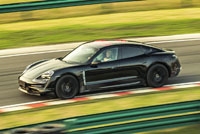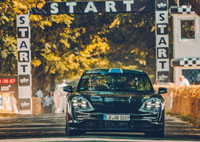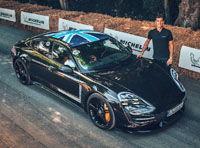
Fans of electric vehicles have been over the moon about the soon to arrive 2020 Taycan, and now that Porsche has a pre-production model strutting its stuff on a global tour, we’re all getting a taste of what’s to come.
The sleek four-door coupe-style Taycan is currently on a “Triple Demo Run” that started off on the first week of July on the Porsche Experience Centre (PEC) handling track in Shanghai, China, where Porsche Carrera Cup Asia driver Li Chao coaxed it around 1.4 kilometres of high-speed curves. This particular Taycan was closest to a street-ready production model anyone outside of Porsche’s inner circle has seen yet, the black-painted model adorned with a stunning red dragon graphic upon its roof.
“The exceptional performance typical for Porsche was a clear development objective for the Taycan. You can sense that right from the start,” an enthusiastic Chao, who was especially impressed by the Taycan’s handling, stated after his initial run. “From uncompromisingly sporty to surprisingly comfortable, the chassis of the new Taycan covers a wide range and successfully combines the precise handling of a sports car and the long-distance comfort of a saloon. In addition to its low centre of gravity, the rear-axle steering also plays a crucial role. The Taycan steers into corners very directly and has plenty of grip.”

The new Taycan houses a quick-charging 800-volt architecture plus a 90-kWh lithium-ion battery, resulting in 592 horsepower (600 PS). The new Porsche catapults from 0 to 100km/h in less than 3.5 seconds, continues on to 200 km/h in under 12 seconds, and tops out above 250 km/h, making it one of the fastest four-door production sedans ever made.
Continuing on its worldwide journey, the new Taycan silently sped up the popular “Hill Run” at the famed West Sussex, England-based Goodwood Estate that hosts the Goodwood Festival of Speed each year. Tasked with driving duties, multiple racing-winning Formula 1 veteran and LMP1/Porsche 919 Hybrid World Endurance Championship (WEC) contender Mark Webber, showed just how awesomely quick the new Porsche can be (make sure to watch the videos below for more).
“The Taycan’s power delivery is awesome,” said Webber. “I took part in this event in a Porsche 911 GT2 RS two years ago, so I already knew that it all comes down to power and traction. But, even for a thoroughbred racing driver like me, it is amazing how the Taycan – even though it’s still a prototype – accelerates off the start and out of the corners.”

Next on the agenda is a New York City stint as part of the ABB FIA Formula E Championship season finale, a fitting event for an electric super sedan. This final demo run will see Formula E driver and 2016 24 Hours of Le Mans winner (while driving a WEC Porsche LMP1 car no less) Neel Jani at the wheel, so be sure to watch all the action on your favourite video streaming site.
While all this ultra-fast electrification is fun for auto enthusiasts everywhere, and mostly seen as a positive for the green movement, no one can say for sure how the Taycan will measure up to its most obvious EV rival when it comes to sales success. The now somewhat long-in-tooth Tesla Model S had led all battery-powered competitors on the sales charts up to the point its own Tesla Model 3 sibling arrived on the scene, so the question now remains whether the Taycan can truly pose a threat to the Model S, or will remain as a niche player like all non-Tesla EV entries so far.
Let’s face it. Tesla virtually owns the electrified sport-luxury market. The Model S, which arrived in 2012, not only outsells all other electric competitors in its mid-size E-segment, but actually outperforms every conventionally powered mid-size luxury model other than the BMW 5 Series and top-selling Mercedes-Benz E-Class. This said, Model S deliveries fell 6.3 percent in 2018, and a much more sizeable 56 percent during the first three months of this year, but this may have more to do with its four-door sedan body style than any lack of interest in the Tesla brand, because both the E-Class and 5 Series found themselves in the same downward spiral, with Audi’s recently redesigned A6 and A7, plus Porsche’s Panamera bucking the trend. Still, despite its downturn, the Model S managed to hang onto third place in the mid-size E-segment.

The Panamera grew by 40.1 percent in calendar year 2018, and didn’t lose much of that market share during Q1 of 2019 either after experiencing a small loss of 0.8 percent. Tesla’s Model S, however, outpaced the Panamera by a near three-to-one ratio last year, and 2.5-to-one over the initial three months of 2019, but it’s nevertheless safe say the recent sales strength of both premium cars is a good sign for potential future success of the new Taycan.
The Panamera, which available with various conventional engines plus two electrified hybrid powertrains, is very close in size to the Model S, at least before taking overall length into account. So far Porsche hasn’t released official Taycan dimensions, but if the production model ends up being close to in size to the Mission E concept it will be slightly shorter, albeit quite a bit wider and significantly lower than either the Panamera or Model S, but it will still fit ideally within the mid-size E-segment.
This brings us to a question: As impressive as the new Taycan appears to be, can the upstart Porsche EV punt the longstanding Tesla titleholder off the top sales-leadership podium? That Jaguar has had difficulty attracting EV customers to its new I-Pace, despite that model being a crossover utility and therefore more in line with current automotive trends, actually makes sense because the British luxury brand already has major problems finding buyers for its conventionally powered models, but Audi, amongst the auto industry’s hotter luxury brands, recently introduced the all-electric E-Tron, a crossover that’s even more traditionally SUV-like, and it hasn’t made much of a dent into Tesla Model X territory either.

To bring you up to date on U.S. EV market growth, June saw increased sector sales of 120 percent, but take note that most of the 29,632 deliveries were attributed to Tesla, its 23,914-unit total accounting for 83 percent of market share growth due to 20,550 Model 3 (a compact luxury D-segment four-door sedan) buyers, 2,725 Model X (a mid-size luxury crossover SUV) customers, and new 1,750 Model S owners. Tesla aside, EV sales from other brands increased by 30 percent in June, which is excellent, but of course this number was comparatively small at 4,718 units total.
As anyone can surmise, earning a profit while selling in small numbers is not going to happen, with the next best-selling Nissan Leaf only able to deliver 1,156 units, Chevy’ impressive Bolt only finding 1,190 buyers (its worst YTD result), Honda positively surprising all with 1,092 Clarity FCV (Fuel Cell Vehicle) deliveries, Audi’s aforementioned E-Tron sales actually dropping from 856 units in May to 726 (after 253 down the road during its first month of April), BMW’s i3 having its best month so far this year with 473 sales, Jaguar’s new I-Pace managing its second-best month with 236 deliveries, Toyota pushing 166 Mirai FCVs out the door, Hyundai’s Kona EV finding 127 new owners, and other EV models like Kia’s Soul EV, Volkswagen’s E-Golf, etcetera not being accounted for due to having their sales numbers combined with conventionally models bearing the same nameplate.
Just which list the new Porsche Taycan gets added to, either alongside Tesla’s strong sales or somewhere mixed in with all other EV makers, is unknown for now, but we only have to wait until later this year to find out. Until the new production Taycan gets officially revealed in September and then arrives in Porsche dealerships later this year, makes sure to enjoy our photo gallery above and collection of videos below.
Kicking off in China: the Porsche Taycan prototype visits Shanghai (1:00):
Porsche Taycan prototype visits Goodwood Festival of Speed 2019 (1:41):
Hey Porsche, watch this video. Love, Electricity (1:03):
Story credits: Trevor Hofmann
Photo credits: Porsche
